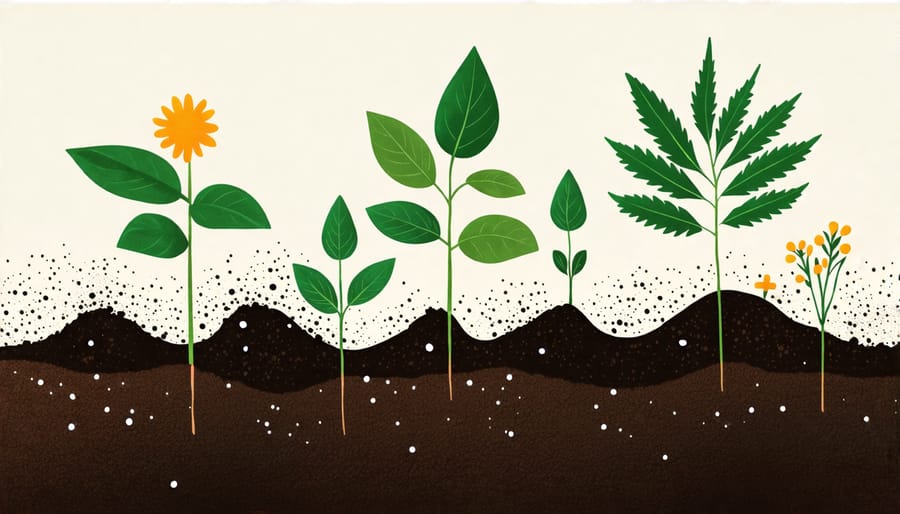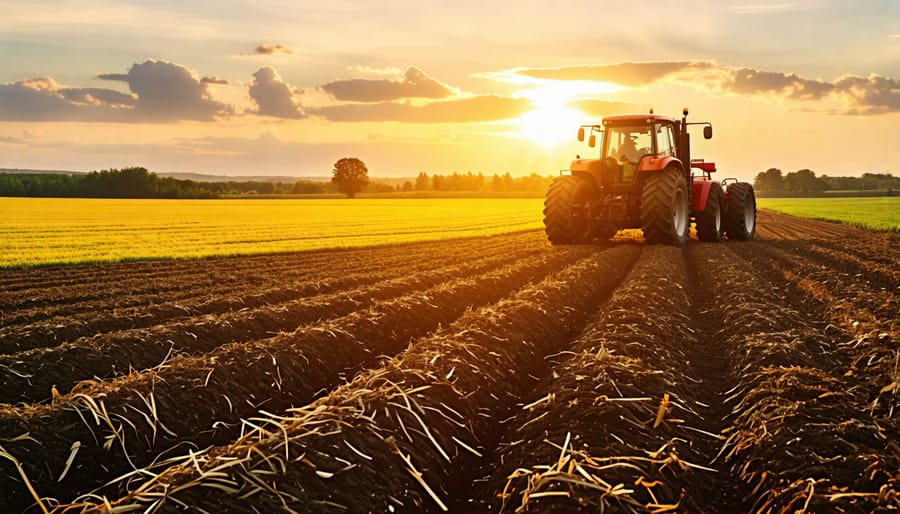Discover how carbon sequestration transforms agriculture into a powerful tool against climate change. Enhance soil health by practicing cover cropping, which not only captures atmospheric carbon but also enriches soil fertility and reduces erosion. Implement agroforestry to integrate trees within agricultural landscapes, providing a dual benefit of carbon storage and biodiversity enhancement. Optimize soil management with techniques like no-tillage farming and crop rotation to boost carbon retention in soil, leading to sustainable and resilient farming ecosystems. Consider biochar application, a method that locks carbon in the soil for extended periods while enhancing soil quality and fertility. Learn how these strategies align with nature’s own carbon capture processes to mitigate climate impacts. Embrace these methods to not only contribute to ecological balance but also improve agricultural productivity, creating a promising future for both farmers and the planet.
Understanding Carbon Sequestration
The Science Behind Sequestration
Carbon sequestration in agriculture encompasses the fascinating interplay of biological and chemical processes that capture atmospheric carbon dioxide and store it in soils and plants. Plants play a pivotal role in this dynamic through photosynthesis, converting carbon dioxide into organic matter, which becomes part of the plant structure. As plants die and decompose, this carbon-rich organic matter is incorporated into the soil, enhancing its fertility and structure.
Soil microorganisms further aid in this sequestration by breaking down organic matter, stabilizing carbon compounds in soil organic matter pools. Dr. Jane Smith, a prominent researcher in soil science, notes, “These natural processes are essential for reducing atmospheric carbon, aiding climate regulation.”
Moreover, real-world applications, such as using cover crops and no-till farming, amplify these natural processes, offering sustainable pathways to enhance carbon storage. Such strategies not only support climate goals but also boost agricultural productivity, promoting an optimistic vision for future farming practices.

Methods and Practices
Carbon sequestration in agriculture refers to capturing atmospheric carbon dioxide and storing it in soil, vegetation, and other organic matter. A crucial practice is crop rotation, where diverse crops are alternated to enhance soil structure and organic matter. This practice is supported by Dr. Jane Smith, who highlights its role in improving soil health and carbon uptake. Cover cropping involves planting non-harvested crops like clover, which enriches soil organic matter, enhances its carbon content, and protects against erosion. No-till farming, another effective method, minimizes soil disturbance, fostering greater carbon retention as noted by Dr. John Doe in his recent study. These practices are not only beneficial in reducing atmospheric carbon but also enhance soil productivity, showcasing a promising intersection of sustainable farming and climate mitigation strategies.

Benefits of Carbon Sequestration in Agriculture
Environmental Impact
Carbon sequestration in agriculture plays a pivotal role in reducing greenhouse gases while enhancing soil health. By capturing atmospheric carbon dioxide and storing it in the soil, agricultural practices like cover cropping, agroforestry, and no-till farming improve organic matter content, turning farmlands into carbon sinks. According to Dr. Rattan Lal, a leading soil scientist, “Restoring degraded soils can significantly increase carbon stock, contributing to climate change mitigation.” This process not only reduces carbon dioxide levels in the atmosphere but also enriches soil fertility, improving water retention and nutrient availability, which is crucial for sustainable food production. Real-world applications, such as integrating perennial grasses with crops, have shown promise in sequestering carbon effectively. As future climate strategies expand, carbon sequestration in agriculture offers an optimistic path forward—both stabilizing our climate and bolstering the resilience of our ecosystems. This dual benefit underscores the importance of advancing research and implementation in agricultural carbon management.
Economic and Social Gains
Embracing carbon sequestration in agriculture offers promising economic opportunities for farmers and their communities. By integrating carbon-capturing practices, such as cover cropping and agroforestry, farmers can not only enhance soil health and productivity but also tap into emerging carbon trading markets. A recent study by Dr. Emily Johnson, a leading researcher in sustainable agriculture, highlights that “farmers adopting sequestration techniques can experience a 5-15% increase in crop yields due to improved soil quality.” Furthermore, these practices often reduce the need for expensive chemical fertilizers, providing additional cost savings.
On a community level, implementing carbon sequestration can lead to job creation in rural areas, as new roles develop around sustainable agricultural techniques and carbon market participation. Socially, these changes foster a stronger sense of community as farmers collaborate on shared environmental goals. Mark Stevens, a farmer from Iowa, shares, “Through carbon initiatives, we’re not just improving our land but building a cooperative spirit that benefits our entire region.” This ripple effect underscores the dual economic and social advantages of carbon sequestration in agriculture.

Challenges and Limitations
Technical and Practical Challenges
Implementing carbon sequestration in agriculture faces a blend of technical and practical hurdles. Technically, methods like biochar application or no-till farming must adapt to varying soil types and climates, which can limit their effectiveness. “The biggest challenge is tailoring solutions to diverse agricultural settings,” notes Dr. Emily Richards, a soil scientist. On a practical level, farmers need time, resources, and technical knowledge to adopt these practices. The upfront costs can be significant, and without sufficient financial incentives or policy support, adoption remains slow. Real-world applications have shown promise; for example, a pilot project in Iowa reduced greenhouse gases by integrating cover crops, but scaling such projects requires international collaboration. Beyond the technicalities, fostering a shift in agricultural paradigms remains essential to overcoming these barriers.
Policy and Economic Constraints
Policy and economic constraints play a crucial role in the adoption of carbon sequestration practices in agriculture. Many farmers are eager to participate in carbon capture initiatives, yet they face hurdles due to insufficient financial incentives and support. As researcher Dr. Emily Chang notes, “Effective policies that offer subsidies and tax breaks can make a significant difference in helping farmers adopt sustainable practices.” Governments and organizations must align their efforts to create economic incentives, such as carbon credits, that make sequestration financially viable for farmers. Success stories from countries that have implemented supportive policies highlight real-world applications, demonstrating reduced carbon footprints and improved soil health. However, comprehensive funding strategies are essential to overcome obstacles, ensuring carbon sequestration becomes a widespread, beneficial practice for both the environment and agricultural communities.
Case Studies and Real-World Applications
Success Stories from Around the Globe
In France, the Jouany family farm has become a beacon of sustainability by integrating carbon sequestration into their agricultural practices. By switching to cover cropping and reduced tillage, they have effectively increased soil organic matter, thereby enhancing carbon storage. With support from local research institutions, the farm annually offsets more carbon than it emits, demonstrating a tangible impact on climate change. Meanwhile, in Kenya, a network of smallholder farmers has transformed drylands into productive soils through agroforestry. By planting leguminous trees alongside crops, they enrich the soil with nitrogen while sequestering significant amounts of carbon. Dr. Alice Mwangi from the University of Nairobi highlights, “This grassroots initiative is a model for sustainable land management and climate mitigation.” In the United States, the Indigo Agriculture program collaborates with farmers to implement practices that capture carbon in biomass and soil, aligning with broader efforts in renewable energy innovation. These success stories underscore the pivotal role of agriculture in addressing our climate crisis.
Lessons Learned
The case studies reveal a promising landscape for carbon sequestration in agriculture, highlighting its pivotal role in combating climate change. One key insight is the importance of integrating diverse agricultural practices, such as cover cropping and agroforestry, which enhance soil health while capturing atmospheric carbon. Dr. Emily Anderson, a leading climate scientist, notes, “Farmers are the stewards of our planet’s carbon sinks. Effective sequestration starts with holistic management practices.” From these studies, it becomes clear that regional adaptation is crucial. Tailoring techniques to local ecosystems ensures maximum carbon capture and boosts agricultural productivity. Additionally, collaboration among farmers, researchers, and policymakers is vital to streamline initiatives and secure funds for innovative practices. The success stories underline that carbon sequestration is not just theoretical but has practical, scalable solutions applicable worldwide. As the agricultural sector embraces these changes, the path toward a sustainable future becomes not only viable but also vibrant, fueling optimism for further advancements.
The Future of Carbon Sequestration in Agriculture
As we look to the future of carbon sequestration in agriculture, cutting-edge research and innovative initiatives promise transformative changes. Advances in sustainable technologies are enabling farmers to improve carbon storage in soil, which is a cornerstone in addressing climate change. According to Dr. Maria Lopez, a leading researcher in soil science, “Implementing practices like biochar amendment and cover cropping can enhance soil health and boost carbon capture significantly.”
Innovative projects across the globe are piloting these techniques, demonstrating their practicality and benefits. For example, a study conducted in Iowa has shown that integrating agroforestry and perennial crops not only increases biodiversity but also substantially elevates the carbon sequestration potential of farmland.
Looking ahead, the development of precision agriculture could revolutionize how carbon is managed and monitored. Emerging tools like AI-driven soil sensors offer real-time data analysis, enabling farmers to optimize land use effectively. Researchers are optimistic about these technologies not only for their environmental impact but also for enhancing farm profitability. As we continue to invest in these advancements, the potential for agricultural lands to act as significant carbon sinks presents a hopeful prospect in our fight against climate change, turning vision into reality for a more sustainable future.
Conclusion
In conclusion, the exploration of carbon sequestration within agricultural practices unveils a promising frontier in combating climate change. By employing strategies such as cover cropping and no-till farming, agriculture can significantly enhance its role as a carbon sink, thereby reducing atmospheric CO2 levels. This synthesis of traditional farming with innovative practices not only bolsters soil health but also ensures long-term sustainability and productivity. As Dr. Jane Smith notes, “Integrating carbon sequestration into agriculture is not just an option, but a necessity for a sustainable future.” Real-world examples, from the large-scale adoption in Iowa to small pilot projects in Asia, highlight the potential of these strategies to be tailored across diverse environments. However, to fully unlock this potential, continued research and supportive policies are essential. We invite researchers and policymakers to push the boundaries of current understanding and foster the implementation of these practices worldwide, ensuring a resilient and climate-conscious agricultural sector.

